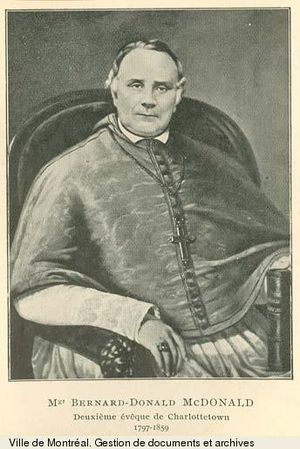
Bernard Donald Macdonald
Encyclopedia

Bishop
A bishop is an ordained or consecrated member of the Christian clergy who is generally entrusted with a position of authority and oversight. Within the Catholic Church, Eastern Orthodox, Oriental Orthodox Churches, in the Assyrian Church of the East, in the Independent Catholic Churches, and in the...
of the Roman Catholic Diocese of Charlottetown
Roman Catholic Diocese of Charlottetown
The Roman Catholic Diocese of Charlottetown is a Roman Catholic diocese which comprises the Canadian province of Prince Edward Island. It is currently led by Bishop Richard John Grecco...
, succeeding Bishop Bernard Angus MacEachern.
Born in St. Andrew's, Prince Edward Island
Prince Edward Island
Prince Edward Island is a Canadian province consisting of an island of the same name, as well as other islands. The maritime province is the smallest in the nation in both land area and population...
, McDonald was one of the first two boys from the Island sent to study for the priesthood at the Grand Seminary of Quebec in 1812, and was ordained there on June 1, 1822, the first native Islander to become a priest. After many years of missionary work, McDonald was appointed Bishop of the Diocese Charlottetown, then comprising Prince Edward Island, New Brunswick
New Brunswick
New Brunswick is one of Canada's three Maritime provinces and is the only province in the federation that is constitutionally bilingual . The provincial capital is Fredericton and Saint John is the most populous city. Greater Moncton is the largest Census Metropolitan Area...
, and the Magdalen Islands
Magdalen Islands
The Magdalen Islands form a small archipelago in the Gulf of Saint Lawrence with a land area of . Though closer to Prince Edward Island and Nova Scotia, the islands form part of the Canadian province of Quebec....
, on February 21, 1837. During his tenure in 1842, New Brunswick broke away to become its own diocese.
Throughout his tenure as Bishop of Charlottetown, McDonald resided in Rustico, where he had also lived as a missionary. A church dedicated to St. Augustine
Augustine of Hippo
Augustine of Hippo , also known as Augustine, St. Augustine, St. Austin, St. Augoustinos, Blessed Augustine, or St. Augustine the Blessed, was Bishop of Hippo Regius . He was a Latin-speaking philosopher and theologian who lived in the Roman Africa Province...
was built there in 1838 under McDonald's supervision and served its purpose for many years. There is still a St. Augustine's Church in Rustico today.
In 1843, the second basilica for St. Dunstan's was built out of wood while McDonald was Bishop. Realizing that the welfare of his priests in the Diocese was important, Bishop McDonald founded the St. Bernard's Society, which would provide for the care of the priests who became inactive due to old age, illness, or other reasons. This society was active until the 1960s.
Although the Bishop closed St. Andrew's College in 1844, he supervised the construction of St. Dunstan's College in Charlottetown (now part of the UPEI campus) in 1848, which attended to the educational needs of boys and girls. In 1857, McDonald was also responsible for bringing to the Island the first Sisters of Notre Dame
Sisters of Notre Dame
Sisters of Notre Dame may refer to:*Congregation of Notre Dame de Montreal*School Sisters of Notre Dame*Sisters of Notre Dame de Namur*Sisters of Notre Dame of Coesfeld...
and opening a convent school for girls, which is now the modern-day Notre Dame Convent in Charlottetown
Charlottetown
Charlottetown is a Canadian city. It is both the largest city on and the provincial capital of Prince Edward Island, and the county seat of Queens County. Named after Queen Charlotte, the wife of George III, Charlottetown was first incorporated as a town in 1855 and designated as a city in 1885...
.
Ill for some time, McDonald moved from Rustico to St. Dunstan's College shortly before his death. Following his death on December 30, 1859, a large funeral mass was held in Charlottetown, and the Bishop's remains were interred in his native home of St. Andrew's.

